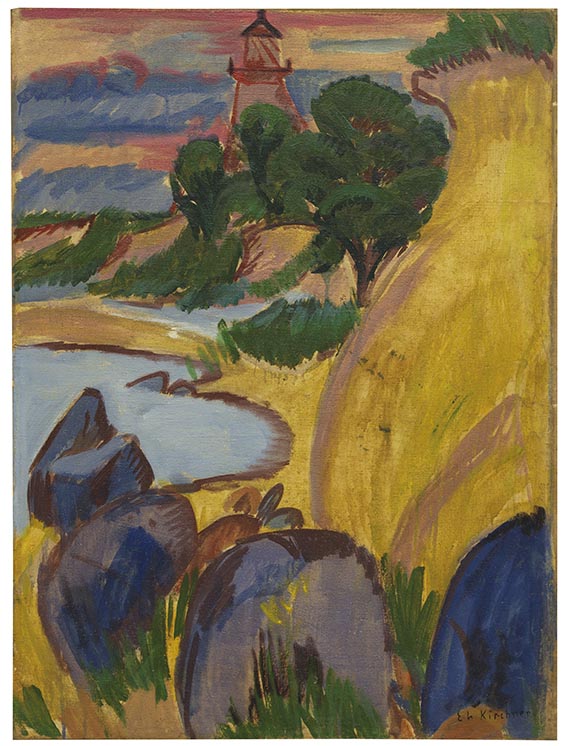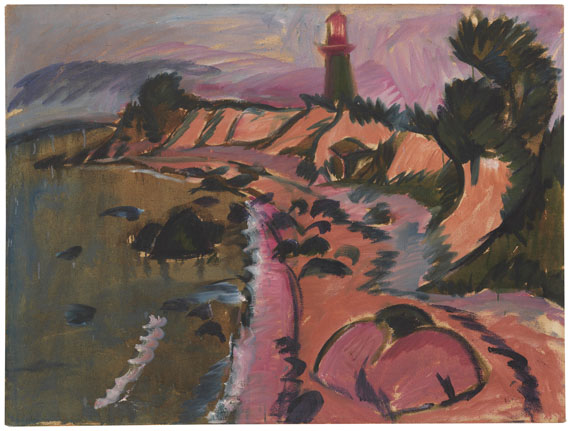Video
Image du cadre
Autre image
14
Ernst Ludwig Kirchner
Leuchtturm hinter Bucht, 1912.
Oil on canvas
Estimation: € 600,000 / $ 696,000
Ernst Ludwig Kirchner
1880 - 1938
Leuchtturm hinter Bucht. 1912.
Oil on canvas.
Signed in the lower right. 102.5 x 77 cm (40.3 x 30.3 in).
The painting is mentioned in Ernst Ludwig Kirchner's "Photoalbum I" as photograph no. 346. [CH].
• Expressive Fehmarn landscape in an impressive size
• A place of refuge and source of inspiration: according to Kirchner, he created works “of absolute maturity” on Fehmarn during the summers of 1912–1914.
• From the “Brücke” period, and the most critical creative phase of Kirchner’s Berlin years.
• Other Kirchner depictions of Fehmarn are in the Nationalgalerie, Berlin, the Folkwang Museum in Essen, the Städel Museum in Frankfurt am Main, the Hamburger Kunsthalle, the Staatsgalerie Stuttgart, the Carnegie Museum of Art in Pittsburgh, and the Detroit Institute of Arts.
• First exhibited in 1916 (Hans Goltz, Munich).
• Fully documented provenance.
• Part of an American private collection for over 65 years.
The work is documented in the Ernst Ludwig Kirchner Archive, Wichtrach/Bern.
PROVENANCE: Artist's estate (Davos 1938, Kunstmuseum Basel 1946).
Stuttgarter Kunstkabinett Roman Norbert Ketterer (acquired from the above in 1954).
Private collection, New York (acquired from the above in 1959).
Since then in family ownership.
EXHIBITION: Vierte Gesamtausstellung, Galerie Neue Kunst - Hans Goltz, Munich, August to October 1916, cat. no. 54 (titled “Bucht beim Leuchtfeuer Staberhuk”).
LITERATURE: Donald E. Gordon, Ernst Ludwig Kirchner, Munich 1968, pp. 84f. and p. 309, CR no. 250 ( illustrated in black and white on p. 309).
- -
Stuttgarter Kunstkabinett, Stuttgart, 34th auction, November 20, 1959, p. 65, lot 308 (with color plate, no. 20, titled “Leuchtturm auf Fehmarn” [Lighthouse on Fehmarn]).
"As you probably know, I returned to Fehmarn this summer after a five-year (sic!) break. I want to go back again next year. The intense impression I had when I first visited has become even stronger, and I painted pictures there that are, as far as I can judge, absolutely mature. Ochre, blue, and green are the colors of Fehmarn, with its wonderful coastline it is even reminiscent of the South Seas here and there [..]."
E. L. Kirchner, 1912, in a letter to his patron Gustav Schiefler, quoted from: Staatsgalerie Stuttgart, www.staatsgalerie.de/de/sammlung-digital/ins-meer-schreitende.
Called up: December 5, 2025 - ca. 17.26 h +/- 20 min.
1880 - 1938
Leuchtturm hinter Bucht. 1912.
Oil on canvas.
Signed in the lower right. 102.5 x 77 cm (40.3 x 30.3 in).
The painting is mentioned in Ernst Ludwig Kirchner's "Photoalbum I" as photograph no. 346. [CH].
• Expressive Fehmarn landscape in an impressive size
• A place of refuge and source of inspiration: according to Kirchner, he created works “of absolute maturity” on Fehmarn during the summers of 1912–1914.
• From the “Brücke” period, and the most critical creative phase of Kirchner’s Berlin years.
• Other Kirchner depictions of Fehmarn are in the Nationalgalerie, Berlin, the Folkwang Museum in Essen, the Städel Museum in Frankfurt am Main, the Hamburger Kunsthalle, the Staatsgalerie Stuttgart, the Carnegie Museum of Art in Pittsburgh, and the Detroit Institute of Arts.
• First exhibited in 1916 (Hans Goltz, Munich).
• Fully documented provenance.
• Part of an American private collection for over 65 years.
The work is documented in the Ernst Ludwig Kirchner Archive, Wichtrach/Bern.
PROVENANCE: Artist's estate (Davos 1938, Kunstmuseum Basel 1946).
Stuttgarter Kunstkabinett Roman Norbert Ketterer (acquired from the above in 1954).
Private collection, New York (acquired from the above in 1959).
Since then in family ownership.
EXHIBITION: Vierte Gesamtausstellung, Galerie Neue Kunst - Hans Goltz, Munich, August to October 1916, cat. no. 54 (titled “Bucht beim Leuchtfeuer Staberhuk”).
LITERATURE: Donald E. Gordon, Ernst Ludwig Kirchner, Munich 1968, pp. 84f. and p. 309, CR no. 250 ( illustrated in black and white on p. 309).
- -
Stuttgarter Kunstkabinett, Stuttgart, 34th auction, November 20, 1959, p. 65, lot 308 (with color plate, no. 20, titled “Leuchtturm auf Fehmarn” [Lighthouse on Fehmarn]).
"As you probably know, I returned to Fehmarn this summer after a five-year (sic!) break. I want to go back again next year. The intense impression I had when I first visited has become even stronger, and I painted pictures there that are, as far as I can judge, absolutely mature. Ochre, blue, and green are the colors of Fehmarn, with its wonderful coastline it is even reminiscent of the South Seas here and there [..]."
E. L. Kirchner, 1912, in a letter to his patron Gustav Schiefler, quoted from: Staatsgalerie Stuttgart, www.staatsgalerie.de/de/sammlung-digital/ins-meer-schreitende.
Called up: December 5, 2025 - ca. 17.26 h +/- 20 min.
Metropolis and Nature
At a time when he was a member of the “Brücke” group in Dresden, Ernst Ludwig Kirchner and his fellow artists Erich Heckel and Hermann Max Pechstein frequently visited the Moritzburg ponds near Dresden to work. Finding counterbalance to everyday life in the modern and increasingly populous city, the artists enjoyed the opportunity to walk naked and uninhibited in nature, bathe, and paint on site in search of a unity between art and nature.
During the Berlin creative years between 1911 and 1917, when the present work was created, the Baltic Sea coast became both E. L. Kirchner's favorite retreat from the city and a seemingly inexhaustible source of inspiration.
His motifs during the years preceding World War I were centered on two contrasting themes: first, the big city after the turn of the century, which Kirchner depicted in his famous “Street Scenes” starting in 1913. Second, the countryside and the connection between people and nature. Hence, his creative work followed a rhythm, partly influenced by the seasons, as well as the contrast between city and country life, entertainment and nature, nightclubs and cliffs. According to Dr. Wolfgang Henze, director of the E. L. Kirchner Archive, “the body of works that Kirchner created on Fehmarn is equal in scope and significance to the works he created in Berlin at the same time [and is] complementary to them” (quoted from: Exhibition catalog E. L. Kirchner. An exhibition marking the 60th anniversary of his death, Kunstforum Vienna, 1998, p. 41).
The Baltic Sea Island of Fehmarn
Accompanied by the siblings Emy and Hans Frisch, Kirchner traveled to the Baltic Sea island of Fehmarn for the first time in 1908. He grew to appreciate the local landscape and a simple way of life that was so different from that in the noisy, hectic, and anonymous city. Over the following years, he elevated the still largely unspoiled, rugged landscape to a significant motif in his artistic work. A nature that was not yet overcrowded with tourists, the cliffs, the sound of the sea, the informality of the bathers, the beautiful, wide sandy beach, the occasionally turbulent winds, high waves, and foaming spray, the vastness of the horizon, the distinctive vegetation with silver poplars, willows, and dune grass, and the large boulders towering between them, provided the painter with energy and served as a great source of inspiration.
In the summer of 1912 (as in the following two years), E. L. Kirchner was accompanied by his new partner, Erna Schilling, whom he had met at a Berlin nightclub a little earlier. At the end of June, they left Berlin and took a train to Fehmarn, where they stayed in the house of the lighthouse keeper Lüthmann at the “Staberhuk” in the southeast of the island until the end of August. The Lüthmann family lived there with eight children, and rented a small attic room to the unmarried couple. Most of the time, they had breakfast with the family and otherwise enjoyed nature, the simple life, and seclusion. The nearest farm was about two kilometers away, and the closest village was four kilometers away. A visit from Kirchner's “Brücke” colleague Erich Heckel and his partner, the dancer Sidi Riha, who stayed in the same room with Kirchner and Erna, provided a little diversion.
“Leuchtturm hinter Bucht” (Lighthouse Behind Bay)
Most of the time, however, the artist is entirely focused on his art and is entirely on his own. He spends most of the day outdoors, bathing, swimming, walking, painting, and carving on the beach below the cliffs—the place where the work offered here was created. From this very perspective, he made pencil sketches and watercolors, as well as other paintings that showcase different viewpoints. The artist did not begin working on larger formats until September, after his return to Berlin.
Preliminary pencil sketches for our painting already reveal Kirchner's final composition. Rocks and coastal formations form the foreground for the lighthouse, which towers in the background, a detail the artist surprisingly omitted in a watercolor, concentrating instead on the composition of the foreground and the color design.
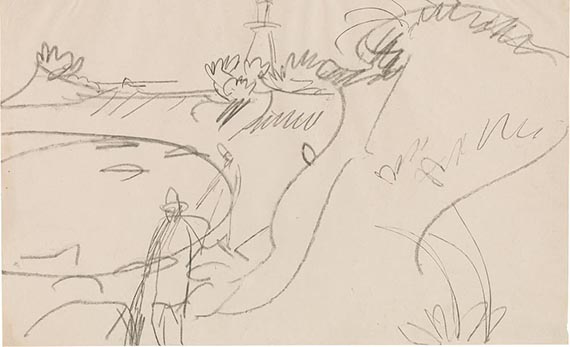

However, the final painting, the one offered here, boasts a masterful play with the richness of forms that architecture and landscape reveal to the Expressionist.
Kirchner shows here – in a multitude of subtly nuanced yet powerful colors – the direct view from the beach towards the lighthouse of Staberhuk, his home at the time, which towers high above a coastal landscape covered in lush green vegetation and dotted with large boulders, cliffs, and sea against the evening sky. Instead of using the classic landscape format, Kirchner chose a portrait format for his landscape, which echoes and emphasizes the elongated shape of the lighthouse. The artist not only depicted the reality he encountered, but also created an almost paradisiacal scene alongside it.
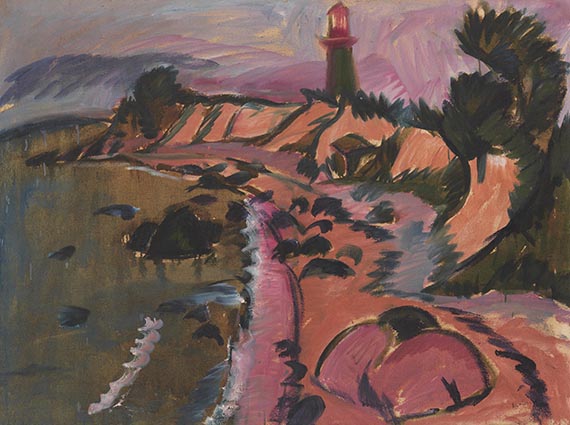
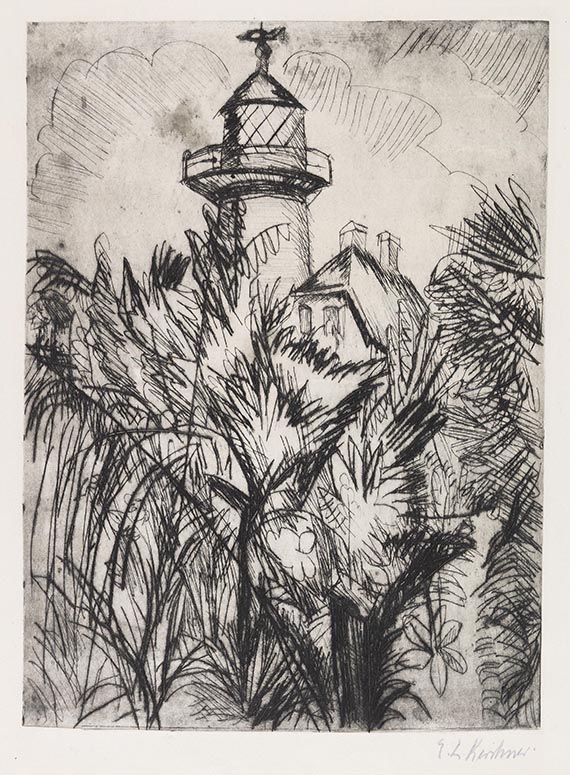
The summer of 1912: Pictures “of absolute maturity”
The landscape pictured here would help Kirchner achieve a particularly fruitful artistic phase not only that summer, but also in the two years that followed, during which he created works of key importance for his oeuvre and for German Expressionism. In an essay about his work of that time, Kirchner noted in retrospect: “From 1912 to 1914, I spent the summer months with Erna on Fehmarn. Here I learned to create the ultimate unity between man and nature, and I completed what I had begun in Moritzburg. The colors became milder and richer, the forms more austere and more distant from their natural counterparts.” (E. L. Kirchner, in: Eberhard W. Kornfeld, Ernst Ludwig Kirchner. Nachzeichnung seines Lebens, exhibition catalog, Basel 1979, p. 337)
While it is not possible to say with certainty whether some of the paintings were created in the summer of 1912 or 1913, the works that can be clearly attributed to his second stay on Fehmarn in 1912 already show a significant development in his painting. The playful lightness of his earlier works from his Dresden “Brücke” years gives way to clearer, more decisive forms and more mature, dynamic compositions, as well as particularly appealing pictorial solutions. The artist also recognizes this progress, writing to his patron Gustav Schiefler in 1912: "As you well know, I was back on Fehmarn this summer after a five-year (sic!) break. I want to go back there next year. The powerful impression I had when I was there for the first time has deepened, and I have painted pictures there that, as far as I can judge, are of absolute maturity. Ochre, blue, and green are the colors of Fehmarn, with a wonderful coastline that sometimes resembles the richness of the South Seas [...]." (E. L. Kirchner, 1912, quoted from: Staatsgalerie Stuttgart, www.staatsgalerie.de/de/sammlung-digital/ins-meer-schreitende)
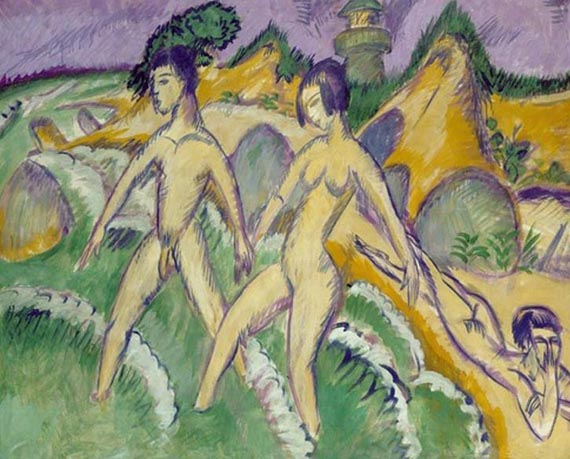
Fehmarn offered Kirchner the greatest possible contrast to the metropolis of Berlin. Together with his new partner, he was able to fulfill his longing for the unity of humanity and nature, experiencing it firsthand and capturing it in his art. Fortunate to have this opportunity, full of energy and artistic creativity, and also deeply in love, Kirchner lived in harmony with his surroundings for a few weeks, initially free from the severe depression he had reported suffering from the previous year.
Happy summer memories
This summer, as well as the two subsequent summers on Fehmarn, left a deep impression on the artist and continued to influence his work. Even in 1916, during the midst of World War I and a time that was challenging for his health, he yearned to return to Fehmarn. Shortly before his third stay at Dr. Kohnstamm's sanatorium in Königstein im Taunus, he wrote in a letter to the collector Karl Ernst Osthaus: "I want to go to Königstein soon. I would rather go up to Fehmarn, but it is closed." (E. L. Kirchner, 1916, in: Dietrich Reinhardt, Brücke-Almanach. Ernst Ludwig Kirchner auf Fehmarn, p. 43)
Shortly afterwards, at the sanatorium, the artist expressed his longing for Fehmarn and the happy summers he had spent there in impressive, monumental murals depicting bathing scenes and motifs inspired by Fehmarn (destroyed by the National Socialists, presumably in 1938).
Even after moving to Switzerland in the 1920s, Erna Schilling and E. L. Kirchner regularly sent parcels containing nutritious food to the family of the lighthouse keeper Lüthmann, as a gesture of gratitude for the beautiful summer stays.
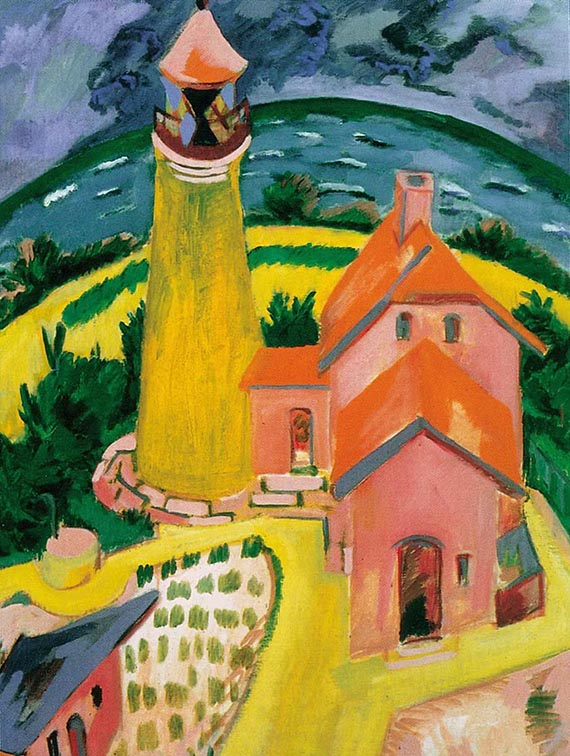
Most of the works created during these important summers on Fehmarn are now in museum collections, including the LWL Museum of Art and Culture, in Münster, the Kunsthalle Bremen, the Osthaus Museum Hagen, the Staatsgalerie Stuttgart, the Städel Museum in Frankfurt am Main, the Hamburger Kunsthalle, the Folkwang Museum in Essen, the Nationalgalerie der Staatlichen Museen zu Berlin, the Aargauer Kunsthaus in Aarau, the Kunstmuseum Liechtenstein, the Art Gallery of New South Wales in Sydney, the Carnegie Museum of Art in Pittsburgh, and the Detroit Institute of Arts. A fact that certainly adds to the significance of this creative period. [CH]
At a time when he was a member of the “Brücke” group in Dresden, Ernst Ludwig Kirchner and his fellow artists Erich Heckel and Hermann Max Pechstein frequently visited the Moritzburg ponds near Dresden to work. Finding counterbalance to everyday life in the modern and increasingly populous city, the artists enjoyed the opportunity to walk naked and uninhibited in nature, bathe, and paint on site in search of a unity between art and nature.
During the Berlin creative years between 1911 and 1917, when the present work was created, the Baltic Sea coast became both E. L. Kirchner's favorite retreat from the city and a seemingly inexhaustible source of inspiration.
His motifs during the years preceding World War I were centered on two contrasting themes: first, the big city after the turn of the century, which Kirchner depicted in his famous “Street Scenes” starting in 1913. Second, the countryside and the connection between people and nature. Hence, his creative work followed a rhythm, partly influenced by the seasons, as well as the contrast between city and country life, entertainment and nature, nightclubs and cliffs. According to Dr. Wolfgang Henze, director of the E. L. Kirchner Archive, “the body of works that Kirchner created on Fehmarn is equal in scope and significance to the works he created in Berlin at the same time [and is] complementary to them” (quoted from: Exhibition catalog E. L. Kirchner. An exhibition marking the 60th anniversary of his death, Kunstforum Vienna, 1998, p. 41).
The Baltic Sea Island of Fehmarn
Accompanied by the siblings Emy and Hans Frisch, Kirchner traveled to the Baltic Sea island of Fehmarn for the first time in 1908. He grew to appreciate the local landscape and a simple way of life that was so different from that in the noisy, hectic, and anonymous city. Over the following years, he elevated the still largely unspoiled, rugged landscape to a significant motif in his artistic work. A nature that was not yet overcrowded with tourists, the cliffs, the sound of the sea, the informality of the bathers, the beautiful, wide sandy beach, the occasionally turbulent winds, high waves, and foaming spray, the vastness of the horizon, the distinctive vegetation with silver poplars, willows, and dune grass, and the large boulders towering between them, provided the painter with energy and served as a great source of inspiration.
In the summer of 1912 (as in the following two years), E. L. Kirchner was accompanied by his new partner, Erna Schilling, whom he had met at a Berlin nightclub a little earlier. At the end of June, they left Berlin and took a train to Fehmarn, where they stayed in the house of the lighthouse keeper Lüthmann at the “Staberhuk” in the southeast of the island until the end of August. The Lüthmann family lived there with eight children, and rented a small attic room to the unmarried couple. Most of the time, they had breakfast with the family and otherwise enjoyed nature, the simple life, and seclusion. The nearest farm was about two kilometers away, and the closest village was four kilometers away. A visit from Kirchner's “Brücke” colleague Erich Heckel and his partner, the dancer Sidi Riha, who stayed in the same room with Kirchner and Erna, provided a little diversion.
“Leuchtturm hinter Bucht” (Lighthouse Behind Bay)
Most of the time, however, the artist is entirely focused on his art and is entirely on his own. He spends most of the day outdoors, bathing, swimming, walking, painting, and carving on the beach below the cliffs—the place where the work offered here was created. From this very perspective, he made pencil sketches and watercolors, as well as other paintings that showcase different viewpoints. The artist did not begin working on larger formats until September, after his return to Berlin.
Preliminary pencil sketches for our painting already reveal Kirchner's final composition. Rocks and coastal formations form the foreground for the lighthouse, which towers in the background, a detail the artist surprisingly omitted in a watercolor, concentrating instead on the composition of the foreground and the color design.

Ernst Ludwig Kirchner, Fehmarnküste mit Leuchtturm, circa 1912, pencil on paper, Galerie Henze & Ketterer, Riehen / Basel.

Ernst Ludwig Kirchner, Der Strand von Fehmarn, 1912, watercolor and pencil on paper, private collection.
However, the final painting, the one offered here, boasts a masterful play with the richness of forms that architecture and landscape reveal to the Expressionist.
Kirchner shows here – in a multitude of subtly nuanced yet powerful colors – the direct view from the beach towards the lighthouse of Staberhuk, his home at the time, which towers high above a coastal landscape covered in lush green vegetation and dotted with large boulders, cliffs, and sea against the evening sky. Instead of using the classic landscape format, Kirchner chose a portrait format for his landscape, which echoes and emphasizes the elongated shape of the lighthouse. The artist not only depicted the reality he encountered, but also created an almost paradisiacal scene alongside it.

Ernst Ludwig Kirchner, Fehmarnküste mit Leuchtturm, 1913, oil on canvas, private collection (formerly Hermann Gerlinger Collection, Würzburg), sold at Ketterer Kunst, Munich, on December 9, 2022, for € 1.225.000.

Ernst Ludwig Kirchner, Leuchtturm im Grünen, Fehmarn, 1913, etching, private collection.
The summer of 1912: Pictures “of absolute maturity”
The landscape pictured here would help Kirchner achieve a particularly fruitful artistic phase not only that summer, but also in the two years that followed, during which he created works of key importance for his oeuvre and for German Expressionism. In an essay about his work of that time, Kirchner noted in retrospect: “From 1912 to 1914, I spent the summer months with Erna on Fehmarn. Here I learned to create the ultimate unity between man and nature, and I completed what I had begun in Moritzburg. The colors became milder and richer, the forms more austere and more distant from their natural counterparts.” (E. L. Kirchner, in: Eberhard W. Kornfeld, Ernst Ludwig Kirchner. Nachzeichnung seines Lebens, exhibition catalog, Basel 1979, p. 337)
While it is not possible to say with certainty whether some of the paintings were created in the summer of 1912 or 1913, the works that can be clearly attributed to his second stay on Fehmarn in 1912 already show a significant development in his painting. The playful lightness of his earlier works from his Dresden “Brücke” years gives way to clearer, more decisive forms and more mature, dynamic compositions, as well as particularly appealing pictorial solutions. The artist also recognizes this progress, writing to his patron Gustav Schiefler in 1912: "As you well know, I was back on Fehmarn this summer after a five-year (sic!) break. I want to go back there next year. The powerful impression I had when I was there for the first time has deepened, and I have painted pictures there that, as far as I can judge, are of absolute maturity. Ochre, blue, and green are the colors of Fehmarn, with a wonderful coastline that sometimes resembles the richness of the South Seas [...]." (E. L. Kirchner, 1912, quoted from: Staatsgalerie Stuttgart, www.staatsgalerie.de/de/sammlung-digital/ins-meer-schreitende)

Ernst Ludwig Kirchner, Ins Meer Schreitende, 1912, oil on canvas, Staatsgalerie Stuttgart.
Fehmarn offered Kirchner the greatest possible contrast to the metropolis of Berlin. Together with his new partner, he was able to fulfill his longing for the unity of humanity and nature, experiencing it firsthand and capturing it in his art. Fortunate to have this opportunity, full of energy and artistic creativity, and also deeply in love, Kirchner lived in harmony with his surroundings for a few weeks, initially free from the severe depression he had reported suffering from the previous year.
Happy summer memories
This summer, as well as the two subsequent summers on Fehmarn, left a deep impression on the artist and continued to influence his work. Even in 1916, during the midst of World War I and a time that was challenging for his health, he yearned to return to Fehmarn. Shortly before his third stay at Dr. Kohnstamm's sanatorium in Königstein im Taunus, he wrote in a letter to the collector Karl Ernst Osthaus: "I want to go to Königstein soon. I would rather go up to Fehmarn, but it is closed." (E. L. Kirchner, 1916, in: Dietrich Reinhardt, Brücke-Almanach. Ernst Ludwig Kirchner auf Fehmarn, p. 43)
Shortly afterwards, at the sanatorium, the artist expressed his longing for Fehmarn and the happy summers he had spent there in impressive, monumental murals depicting bathing scenes and motifs inspired by Fehmarn (destroyed by the National Socialists, presumably in 1938).
Even after moving to Switzerland in the 1920s, Erna Schilling and E. L. Kirchner regularly sent parcels containing nutritious food to the family of the lighthouse keeper Lüthmann, as a gesture of gratitude for the beautiful summer stays.

Ernst Ludwig Kirchner, Leuchtturm Staberhuk, Fehmarn, 1912, oil on canvas, Carnegie Museum of Art, Pittsburgh.
Most of the works created during these important summers on Fehmarn are now in museum collections, including the LWL Museum of Art and Culture, in Münster, the Kunsthalle Bremen, the Osthaus Museum Hagen, the Staatsgalerie Stuttgart, the Städel Museum in Frankfurt am Main, the Hamburger Kunsthalle, the Folkwang Museum in Essen, the Nationalgalerie der Staatlichen Museen zu Berlin, the Aargauer Kunsthaus in Aarau, the Kunstmuseum Liechtenstein, the Art Gallery of New South Wales in Sydney, the Carnegie Museum of Art in Pittsburgh, and the Detroit Institute of Arts. A fact that certainly adds to the significance of this creative period. [CH]
14
Ernst Ludwig Kirchner
Leuchtturm hinter Bucht, 1912.
Oil on canvas
Estimation: € 600,000 / $ 696,000
Commission, taxes et droit de suite
Cet objet est offert avec imposition régulière.
Calcul en cas d'imposition régulière:
Prix d’adjudication jusqu’à 1 000 000 euros : frais de vente 29%.
Des frais de vente de 23% sont facturés sur la partie du prix d’adjudication dépassant 1 000 000 euros. Ils sont additionnés aux frais de vente dus pour la partie du prix d’adjudication allant jusqu’à 1 000 000 euros.
Des frais de vente de 15 % sont facturés sur la partie du prix d’adjudication dépassant 4 000 000 euros. Ils sont additionnés aux frais de vente dus pour la partie du prix d’adjudication allant jusqu’à 4 000 000 euros.
La taxe sur la valeur ajoutée allemande, actuellement de 7 %, est perçue sur la somme du prix d’adjudication et des frais de vente.
Pour les entreprises habilitées à déduire la TVA, le régime fiscal général peut être appliqué.
Calcul en cas de droit de suite:
Pour les œuvres originales d’arts plastiques et de photographie d’artistes vivants ou d’artistes décédés il y a moins de 70 ans, soumises au droit de suite, une rémunération au titre du droit de suite à hauteur des pourcentages indiqués au § 26, al. 2 de la loi allemande sur les droits d’auteur (UrhG) est facturée en sus pour compenser la rémunération liée au droit de suite due par le commissaire-priseur conformément au § 26 UrhG. À ce jour, elle est calculée comme suit :
4 pour cent pour la part du produit de la vente à partir de 400,00 euros et jusqu’à 50 000 euros,
3 pour cent supplémentaires pour la part du produit de la vente entre 50 000,01 et 200 000 euros,
1 pour cent supplémentaire pour la part entre 200 000,01 et 350 000 euros,
0,5 pour cent supplémentaire pour la part entre 350 000,01 et 500 000 euros et
0,25 pour cent supplémentaire pour la part au-delà de 500 000 euros.
Le total de la rémunération au titre du droit de suite pour une revente s’élève au maximum à 12 500 euros.
Calcul en cas d'imposition régulière:
Prix d’adjudication jusqu’à 1 000 000 euros : frais de vente 29%.
Des frais de vente de 23% sont facturés sur la partie du prix d’adjudication dépassant 1 000 000 euros. Ils sont additionnés aux frais de vente dus pour la partie du prix d’adjudication allant jusqu’à 1 000 000 euros.
Des frais de vente de 15 % sont facturés sur la partie du prix d’adjudication dépassant 4 000 000 euros. Ils sont additionnés aux frais de vente dus pour la partie du prix d’adjudication allant jusqu’à 4 000 000 euros.
La taxe sur la valeur ajoutée allemande, actuellement de 7 %, est perçue sur la somme du prix d’adjudication et des frais de vente.
Pour les entreprises habilitées à déduire la TVA, le régime fiscal général peut être appliqué.
Calcul en cas de droit de suite:
Pour les œuvres originales d’arts plastiques et de photographie d’artistes vivants ou d’artistes décédés il y a moins de 70 ans, soumises au droit de suite, une rémunération au titre du droit de suite à hauteur des pourcentages indiqués au § 26, al. 2 de la loi allemande sur les droits d’auteur (UrhG) est facturée en sus pour compenser la rémunération liée au droit de suite due par le commissaire-priseur conformément au § 26 UrhG. À ce jour, elle est calculée comme suit :
4 pour cent pour la part du produit de la vente à partir de 400,00 euros et jusqu’à 50 000 euros,
3 pour cent supplémentaires pour la part du produit de la vente entre 50 000,01 et 200 000 euros,
1 pour cent supplémentaire pour la part entre 200 000,01 et 350 000 euros,
0,5 pour cent supplémentaire pour la part entre 350 000,01 et 500 000 euros et
0,25 pour cent supplémentaire pour la part au-delà de 500 000 euros.
Le total de la rémunération au titre du droit de suite pour une revente s’élève au maximum à 12 500 euros.




 Lot 14
Lot 14 